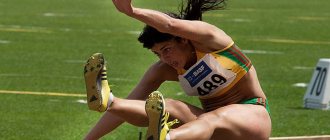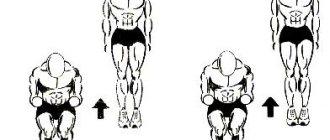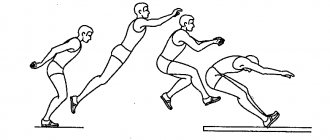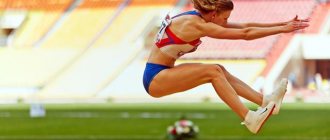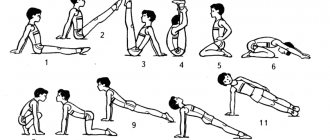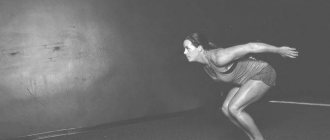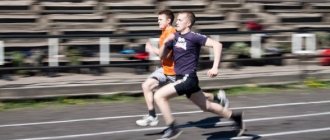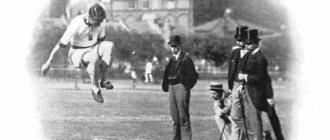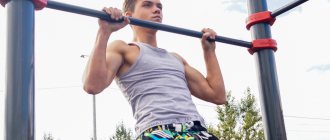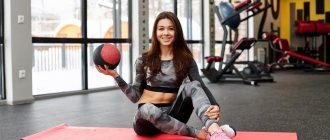Currently, in athletics competitions are held in four main types of running jumps: high jump, long jump, triple jump and pole vault. The goal of athletics jumping is to jump as high or far as possible. Based on this, in accordance with motor tasks, long jumps and triple jumps can be conditionally combined into one group, and high jumps and pole jumps into another group.
Sports results in athletics jumping depend on two main factors - the initial speed and the angle of departure of the jumper’s body. The flight part of each jump has its own characteristics and the corresponding trajectory of the athlete’s CGT.
Each of the athletics jumps is a complete exercise, but for the convenience of analyzing the technique, it can be divided into the following components:
- run-up and preparation for take-off (from the start of the run-up to the moment of placing the foot at the take-off site);
- repulsion (from the moment the pushing leg is placed on the support and until it is lifted off);
- flight (from the moment the pushing leg lifts off the support until landing);
- landing (from the moment of touching the landing site until the athlete’s body completely stops moving).
Each of the components of the jump plays a certain role in achieving a high sports result, but their specific weight is not the same. It can be considered that take-off is of greatest importance, then run-up (in standing jumps, i.e. without a run-up, the result is much worse), flight (in the unsupported phase it practically cannot affect the given trajectory of the OCTT in any way) and landing, which affects the results only in the long jump and triple jump.
Run-up and preparation for take-off
Considering that the flight range and altitude depend on the initial speed and angle of departure of the body, the athlete performs a take-off run to create the required horizontal speed. This value in each type of jump should be optimal, based on the corresponding motor tasks. Therefore, in long and triple jumps, the take-off speed at the moment of take-off should be close to the maximum (for the best jumpers in the world it reaches 11 m/s and higher). To achieve such a speed, an appropriate run-up length is needed: for men up to 45 m (20-24 running steps), for women up to 35 m (18-20 running steps).
When performing high jumps, the optimal speed is significantly lower than the maximum (6-8 m/s), and therefore the run-up length is in the range of 12-25 m (7-13 running steps). In pole vaulting, the athlete strives to gain maximum speed, but it turns out to be lower than the maximum speed due to the inconvenience that arises when carrying the pole.
In all types of jumps, the run-up is performed with acceleration, the highest speed is achieved in the last three to four steps of the run-up. At this time, due to changes in the tempo and rhythm of steps, as well as the ratio of their lengths, preparation for take-off begins, associated in most cases with a slight decrease in the previously acquired speed.
In preparation for repulsion, due to a slight increase in the length of the penultimate step, the CGT decreases slightly. In the last step, which is usually somewhat shorter than the penultimate one, the athlete actively moves the pelvis and pushing leg forward. The forward pushing leg, creating a braking force, somewhat slows down the horizontal speed, but at the same time increases the pressure on the ground, which causes an increase in the support reaction, which helps convert the horizontal speed to vertical. If these actions are effective in high jumps, then in long jumps, triple jumps and pole vaults their role is minimal, since in these cases the ratio of the length of the last three to four steps of the run-up is very important and the method of performing them has some features in each type of jump.
Placing the almost straightened pushing leg at the take-off point in all types of jumps is performed quickly and energetically. The fulcrum should always be slightly ahead of the OCTT projection on the ground, and the greater the take-off angle, the further forward the leg is placed. This distance is greatest in the high jump and significantly less in the long, triple and pole jumps.
Basic Rules
There are several rules by which people compete in this sport:
- Competitions take place in a designated place on a horizontal surface covered with synthetic materials. The size of the sector should allow a run of 15 meters, a run length of 40 m, and a width of over 120 mm.
- The size of the athletes' landing area is made of foam rubber and is 5 m x 5 m x 0.5 m. The placement of the mats and stands faces each other with a gap of 100 mm.
- A strip (metal or plastic) 4 m long, with a circular cross-section of 3 cm, weighing up to 2 kg. It should be painted in light colors, with 3-4 dark stripes of 200 mm each applied across it. The ends of the crossbar are 150 mm each, the semicircular section is 30 mm. The plates with a crossbar installed on them measure 6 x 4 cm. The crossbar holders are located at a distance of 400 cm from each other.
- The racks must have a device that allows you to install the crossbar at a height of up to 2.5 m.
- Athletes' performances are determined by drawing lots. For each attempt, 1 minute is allocated after the announcement, the jumpers perform them one by one. Each athlete is allocated 3 minutes.
- The initial height and its change are determined by the position adopted in the competition. When setting the next height level, the crossbar is raised by 2 cm, for all-around - by 3 cm. Each athlete begins to work from any height offered to him. Each height is taken from three passes. It is allowed to omit any of the heights. If three unsuccessful attempts occur in a row, the jumper is no longer allowed to compete.
- The place is assigned according to the results of the greatest number of heights overcome. When several participants have the same results, the winner is the athlete who reached the last height and made fewer attempts. If several participants overcome the last height with an equal number of attempts, primacy is given to the jumper with the fewest unsuccessful attempts.
- When an athlete's pole breaks during a run, he can make another run.
- The judge will mark all correctly completed entries by raising a white flag.
Repulsion
The main task of repulsion is to change the direction of movement of the athlete’s CGT by a certain upward angle. As a result of the redistribution of horizontal speed into vertical speed, the initial take-off speed of the jumper’s body is always less than the take-off speed. The greater the distance from the point of projection of the OCTT to the place of support when placing the pushing leg, the greater the loss of speed.
When placing the take-off position, a slight shock-absorbing flexion of the supporting leg occurs in the hip and knee joints, and some flexion of the spine is also possible. Consequently, the jumper’s CGT first approaches the place of support, and then, as the body extends, moves away from it. Typically, shock-absorbing flexion ends when the shin of the jumper's pushing leg takes a vertical position, after which extension begins in all joints.
The pushing leg at the moment of contact with the ground experiences a large load, which is absorbed by the tension and simultaneous stretching of the muscles - the extensors of the supporting leg due to their elasticity. The faster (within optimal limits) the muscles are stretched, the more effective the strength and speed of their contraction are. Therefore, in order to improve the repulsion efficiency, the shock absorption should be carried out over a relatively short path.
It is very important to perform the push-off as quickly as possible, and extension in various joints occurs in a certain sequence: first the spine is straightened and the hip joints are extended, then the knee joints, and the straightening of the leg ends with plantar flexion of the ankle joint.
In all types of jumps, it is important to perform swing movements with the legs and arms. During the accelerated lift of the swing leg, the reactive force of the swing increases the pressure on the support and increases the load on the muscles of the supporting leg. However, at the end of the swing, when positive acceleration turns into negative (deceleration) and the energy of the moving swing leg is transferred to the rest of the body mass, the load on the muscles of the supporting leg decreases sharply and the excess potential of muscle tension ensures a faster and more powerful contraction.
From a biomechanical point of view, a straight leg swing is more effective. At the same time, its center of gravity is located at a slightly greater distance from the hip joint, which, at the same angular velocity, creates a higher linear speed and accordingly increases the traction force. However, performing a swing with a straight leg is only possible in high jumps using the “flip”, “roll”, “step over” and “wave” methods, which are performed at a relatively low take-off speed. In the long, triple and pole jumps, as well as in the high jumps using the Fosbury flop method, the swing is carried out with a bent leg, but at a higher speed.
In a single concentrated effort of the athlete when pushing off, simultaneously with straightening the pushing leg and torso, the jumper should strive to make the most active movements possible not only with the leg, but also with the arms. This contributes to the greatest rise in OCTT before takeoff, which improves athletic performance.
The magnitude of this angle largely depends on the position of the OCTT relative to the support at the moment of repulsion. In high jumps and pole vaults, the take-off angle is 80-85°, in long and triple jumps - 65-70°. However, taking into account the addition of the vertical speed created during take-off and the horizontal speed acquired during the run-up, the resulting angle of departure of the athlete’s body in high jumps is 65-70°, and in long and triple jumps - 18-25°.
Bibliography:
- Vavilova, E. N. Teach to run, jump, climb, throw: a manual for children's educators. garden / E. N. Vavilova. – M.: Education, 1983. – 144 p.
- Keneman A.V., Khukhlaeva D.V. Theory and methods of physical education of preschool children: a textbook for pedagogical students. in-tov on spec. “Preschool pedagogy and psychology” / A.V. Keneman, D.V. Khukhlaeva - ed. 2nd, rev. and additional – M.: Education, 1978. – 272 p.
- Osokina, T.I. Physical education in kindergarten, 3rd ed., revised / T. I. Osokina T. I. – M.: Education, 1986. – 304 p.
- Osokina, T.I. Physical exercises for preschoolers / T.I. Osokina, E.A. Timofeeva. – Edition 2, supplemented. – Moscow: Education, 1971. – 159 p.
- Stepanenkova, E.Ya. Theory and methods of physical education and child development: textbook. aid for students higher ped. textbook institutions / E.Ya. Stepanenkova. – M.: Academy, 2001. – 368 p.
- Khukhlaeva, D.V. Methods of physical education in preschool institutions: textbook. for ped. special education school 2010 “Education in preschool. institutions" and 2002 "Doshk. education" / D. V. Khukhlaeva. – 3rd ed., revised. and additional – M.: Education, 1984. – 207 p.
- Shebeko, V.N. Theory and methods of physical education of preschool children: textbook. aid for students higher textbook establishments / V.N. Shebeko. – Minsk: “Higher School”, 2010. – 288 p.
Flight
After repulsion is completed, the flight phase begins, in which the OCTT describes a certain trajectory, depending on the takeoff angle and initial speed. The jumper is not able to change this trajectory, however, due to appropriate motor actions, he can change the location of the body and its individual parts relative to his OCTT. In this case, the movement of some parts of the body in one direction causes compensatory movements of its other parts in the opposite direction.
In high jumps and pole vaults, the athlete needs to take these laws into account when crossing the bar, since in some cases it is possible to achieve such a position that the jumper, going around the bar, can carry his OCTT under it, since this is not a material, but an imaginary point and in some poses (horseshoe position) may be outside the body. Therefore, it is more profitable for the athlete to transfer the body over the bar not immediately, but sequentially, so that by actively lowering some parts of the body, he can transfer others.
In long jumps and triple jumps, movements in flight allow you to maintain a stable position and create favorable conditions for a rational landing.
The range of a running long jump can theoretically be determined by the formula: \[s=\frac{{v}^{2}sin2a}{g},\] where s is the jump range, v is the initial take-off speed, a is the take-off angle , g is the acceleration due to gravity.
Way. Gymnastic jump
The simplest and most popular type is the gymnastic method. It was primarily used by track and field athletes and gymnasts. In this case, you need to take a good run and jump just before the bar so that your two bent legs touch your chest. In this case, the landing occurs on two legs. This method requires a lot of skill, because you need to jump high and move the center of gravity over the bar without additional means.
Interesting: 8 ways to determine damage
Landing
The meaning of landing and the nature of its implementation are not the same in different types of jumps. In high jumps and pole vaults, this phase no longer has any influence on the result, so its main purpose is to ensure the safety of the athlete. In the long and triple jumps, in addition to ensuring safety, the landing method has a significant impact on the result. In this regard, jumpers must strive to ensure that when landing, their heels touch the ground in front of or coincide with the OCTT landing trajectory point.
It should be noted that during landing the athlete’s body experiences, although short-term, significant stress. Slowing down of movement occurs both due to shock-absorbing flexion in the hip, knee and ankle joints, and due to deformation of the landing site. In order to reduce muscle tension and prevent injury, athletes are recommended to lengthen the braking path of the body when landing.
World records
Below is the sequence of achievements in this discipline over the past decades in the world:
| Records | Jumpers | From what country | Competition date | Record location | |
| Floor | Name | ||||
| 245 cm | men | H. Sotomayor | Cuba | 07/27/93 | Salamanca (Spain) |
| 209 cm | women | S. Kostadinova | Bulgaria | 08/30/87 | Rome, Italy) |
| 243 cm | men | H. Sotomayor | Cuba | 03/04/89 | Budapest, Hungary) |
| 208 cm | women | K. Bergquist | Sweden | 02/04/06 | Arnstadt (Germany) |
As you can see, this type of athletics discipline helps jumpers to be in good physical shape, trains endurance, flexibility and strength skills, and also makes it possible to achieve high results.
Jumping Sports Sports and fitness Athletics
